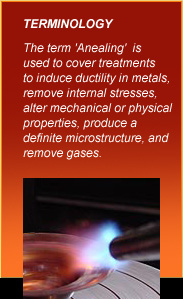

Flame Annealing
A
process to which metal is heated then cooled in order to remove stresses
or soften material for improved machinability or formability.
![]()
There are ten different
forms of annealing - each with its own specialty and purpose. Tri-State Flame will recommend and help select the best form to optimize your results.
![]() • Process Anneal
• Process Anneal
![]() • Subcritical
Anneal
• Subcritical
Anneal
![]() • Intercritical
Anneal
• Intercritical
Anneal
![]() • Intermediate
Anneal
• Intermediate
Anneal
![]() • Recovery
Anneal
• Recovery
Anneal
![]() • Recrystallization
Anneal
• Recrystallization
Anneal
![]() • Isothermal
Anneal
• Isothermal
Anneal
![]() • Spheroidize
Anneal
• Spheroidize
Anneal
![]() • Full Anneal
• Full Anneal
![]() • Solution
Anneal
• Solution
Anneal
Process Anneal: (500 - 1400°F)
Low temperature anneal typically used for material (ferrous or nonferrous)
that is going to be reworked via cold rolling or drawing. This type of
anneal is also applied to material to improve formability for forming/bending
operations with reduced risk of distortion associated with intercritical
or full annealing.
Subcritical Anneal: (500 - 1400°F)
Annealing process conducted at a temperature below the lower critical
for ferrous material and below the full anneal temperature for nonferrous
materials. Also referred to as “process annealing”. This anneal
is used to restore ductility to the material for subsequent cold-working/forming
operations.
Intercritical Anneal: (1335 - 1600°F)
Annealing process typically applied to ferrous material heated to and
held at a temperature between the upper and lower critical temperatures
for ferrous materials.
Intermediate Anneal: (500 - 1400°F)
Annealing process conducted at a temperature below the lower critical
for ferrous material and below the full anneal temperature for nonferrous
materials. Also referred to as “process annealing”. This anneal
is used to restore ductility to the material between cold-working or hot-working
operations.
Recovery Anneal: (300 - 1000°F)
Annealing process typically applied to cold-worked material to reduce
residual stresses and recover ductility in the material. Temperatures
used are below those required for recrystallization or new grain formation.
Recrystallization Anneal: (330 - 1450°F)
Annealing process typically applied to cold-worked metal to produce a
new grain structure without going through a phase change in the case of
ferrous materials.
Isothermal Anneal: (1300 - 1650°F)
Annealing process for ferrous materials partially of fully austenitize,
followed by slow cooling to below the lower critical temperature and held
for transformation to a soft, coarse pearlite(aggregate of ferrite and
iron carbide).
Spheroidize Anneal: (1200 - 1400°F)
Annealing process for ferrous materials(medium to high carbon, low alloy
steel) to produce a structure of globular carbides in a ferritic matrix
for improved formability and machining.
Full Anneal: (650 - 1650°F)
Annealing process for ferrous and nonferrous materials for produce the
softest, stress-free structure for improved machinability, cold-workability,
mechanical or electrical properties, and dimensional stability. For ferrous
materials, heat to above the upper critical transformation temperature
and hold to obtain full austenitization, and slow cool to ambient temperature.
For nonferrous materials, heat at the specified alloy anneal temperature,
hold for a specified time, and furnace cool to ambient temperature.
Solution Anneal: (900 - 2250°F)
Annealing process for ferrous and nonferrous materials to produce a solid
solution of alloy elements for age-hardening or precipitation-hardening,
or improved machining, formability, and/or corrosion resistance. This
process is comprised of heating to a specified temperature, holding for
a specified time, and cooling rapidly to ambient temperature. This process
is typically the precursor to an age-hardening operation for precipitation
- hardenable alloys.